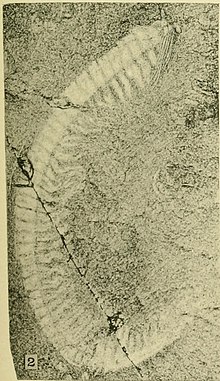| Worthenella Temporal range:
| |
|---|---|

| |
| Type specimen of W. cambria in shale | |
| Scientific classification | |
| Domain: | Eukaryota |
| Kingdom: | Animalia |
| Phylum: | Arthropoda |
| Class: | incertae sedis |
| Family: | †Kootenichelidae |
| Genus: | †Worthenella Walcott, 1911[1] |
| Type species | |
| Worthenella cambria Walcott, 1911[1]
| |
Worthenella is a genus of enigmatic arthropod from the Burgess Shale. It known from a single specimen described initially as an annelid by Charles Doolittle Walcott in 1911. The body is elongate and myriapod-like with a head and at least 46 body segments. The head bears poorly preserved appendages, while filamentous branched structures appear to run along the underside of the first 34 trunk segments, with the posterior 8 suggested to have had longer appendages.[2] In 2013, David Legg placed it in the family Kootenichelidae as a sister to Kootenichela , based on the supposed presence of antenniform head appendages.[3] However, this position was questioned in a later study, which argued that the supposed antenniform appendages were actually taphonomic artefacts.[4]
- ^ a b Cite error: The named reference
Walcott1911was invoked but never defined (see the help page). - ^ "Worthenella cambria". The Burgess Shale. Royal Ontario Museum. Retrieved 2023-01-13.
- ^ Legg, David (2013). "Multi-Segmented Arthropods from the Middle Cambrian of British Columbia (Canada)". Journal of Paleontology. 87 (3): 493–501. Bibcode:2013JPal...87..493L. doi:10.1666/12-112.1. S2CID 86725173.
- ^ Lamsdell, James C.; Stein, Martin; Selden, Paul A. (September 2013). "Kodymirus and the case for convergence of raptorial appendages in Cambrian arthropods". Naturwissenschaften. 100 (9): 811–825. Bibcode:2013NW....100..811L. doi:10.1007/s00114-013-1081-y. ISSN 0028-1042. PMID 23893175. S2CID 253635469.